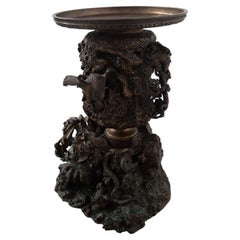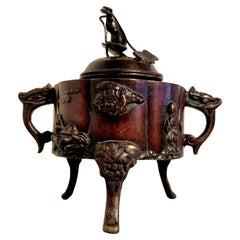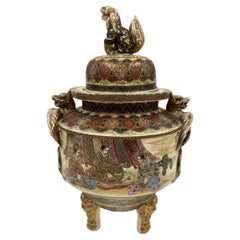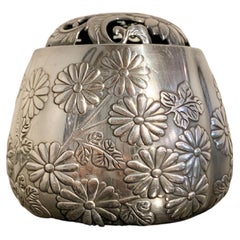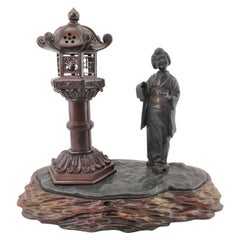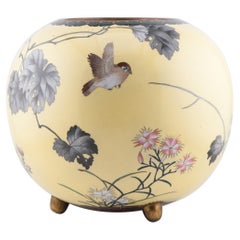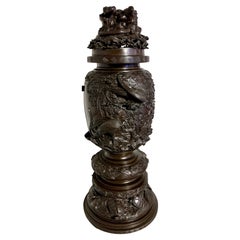Meiji Incense Burner
Antique 1830s Japanese Meiji Candlesticks
Bronze
Antique Early 1900s Japanese Meiji Scholar's Objects
Bronze
Early 20th Century Japanese Chinese Export Urns
Porcelain
Antique 1890s Japanese Meiji Jars
Bronze, Enamel
Vintage 1910s Japanese Meiji Metalwork
Silver, Sterling Silver
Antique Late 19th Century Japanese Meiji Sculptures and Carvings
Bronze
Antique 19th Century Japanese Meiji Metalwork
Porcelain
Antique 19th Century Japanese Meiji Religious Items
Bronze
Antique Late 19th Century Japanese Meiji Metalwork
Bronze
Antique Late 19th Century Japanese Meiji Ceramics
Silver, Metal
Antique 1890s Japanese Meiji Ceramics
Silver
Antique 19th Century Japanese Meiji Ceramics
Metal, Bronze
Antique Mid-19th Century Japanese Meiji Urns
Bronze
Early 20th Century Japanese Meiji Metalwork
Bronze
Antique 19th Century Japanese Decorative Bowls
Porcelain
Antique 19th Century Japanese Decorative Bowls
Porcelain
Antique 1890s Ceramics
Enamel
Antique Late 19th Century Japanese Meiji Metalwork
Bronze
Antique Late 19th Century Japanese Animal Sculptures
Marble, Bronze
Antique 19th Century Japanese Edo Antiquities
Enamel
Antique 19th Century Chinese Planters, Cachepots and Jardinières
Porcelain
Antique Late 19th Century Japanese Meiji Candlesticks
Bronze
Antique Late 19th Century Japanese Meiji Metalwork
Bronze
Antique Late 19th Century Japanese Meiji Ceramics
Ceramic
Antique Late 19th Century Japanese Meiji Metalwork
Enamel
Antique Late 19th Century Japanese Meiji Ceramics
Pottery
21st Century and Contemporary Japanese Meiji Jewelry Boxes
Gold
Antique 19th Century Dutch Meiji Planters, Cachepots and Jardinières
Porcelain
Early 20th Century Japanese Meiji Metalwork
Silver, Bronze
Antique 19th Century Japanese Meiji Ceramics
Metal, Bronze
Antique 19th Century Japanese Meiji Ceramics
Earthenware
Antique 19th Century Japanese Meiji Animal Sculptures
Bronze
21st Century and Contemporary Japanese Meiji Jars
Gold
Antique 1890s Japanese Metalwork
Silver
Antique Early 1900s Japanese Meiji Ceramics
Ceramic, Earthenware, Pottery
Early 20th Century Japanese Meiji Ceramics
Porcelain
Antique Late 19th Century Japanese Meiji Metalwork
Silver
Antique Early 1900s Japanese Meiji Metalwork
Bronze
Antique Late 19th Century Japanese Metalwork
Bronze
Antique 19th Century Japanese Metalwork
Bronze
Early 20th Century Japanese Meiji Metalwork
Bronze
Antique 1870s Japanese Meiji Metalwork
Bronze
Antique Late 19th Century Japanese Animal Sculptures
Bronze
Early 20th Century Japanese Animal Sculptures
Bronze
Antique Early 1900s Japanese Meiji Metalwork
Bronze
Antique Late 19th Century Japanese Meiji Ceramics
Ceramic, Earthenware, Pottery
Antique 1880s Japanese Meiji Ceramics
Porcelain
Antique Late 19th Century Japanese Meiji Ceramics
Bronze
Antique 19th Century Japanese Ceramics
Pottery
Antique 1880s Japanese Meiji Metalwork
Bronze
Antique Late 19th Century Japanese Metalwork
Bronze
Antique Late 19th Century Japanese Meiji Sculptures and Carvings
Bronze
Antique Late 19th Century Japanese Meiji Metalwork
Bronze
Antique 19th Century Japanese Meiji Metalwork
Bronze
Antique 19th Century Japanese Meiji Metalwork
Bronze
Antique 19th Century Japanese Meiji Metalwork
Bronze
Antique 19th Century Japanese Meiji Ceramics
Metal, Bronze
Early 20th Century Japanese Meiji Figurative Sculptures
Bronze
Early 20th Century Japanese Meiji More Asian Art, Objects and Furniture
Antique 1890s Japanese Meiji Metalwork
Bronze
- 1
Meiji Incense Burner For Sale on 1stDibs
How Much is a Meiji Incense Burner?
Finding the Right Asian-art-furniture for You
From Japanese handmade earthenware pottery, originating circa 14,500 B.C. and adorned with elaborate corded patterns known as jōmon, to natural elm case pieces and storage cabinets built in Qing dynasty–era China to mid-century Thai rice-paper charcoal rubbings, antique and vintage Asian art and furniture make for wonderful additions to all kinds of contemporary interiors.
Eastern elements elevate any home’s decor. Introduce zen sensibility to your living room, dining room and bedroom with the neutral color palettes and the natural materials such as rattan, bamboo and elm that we typically associate with traditional Asian furniture. Decorative handwoven embroideries and textiles originating from India and elsewhere on the continent, which can be draped over a bed or sofa or used as a wall hanging, can be as practical as they are functional, just as you wouldn’t seek out Japanese room-divider screens — often decorated with paintings but constructed to be lightweight and mobile — merely for privacy.
With everything from blanket chests to lighting fixtures to sculptures and carvings, it’s easy to tastefully bring serenity to your living space by looking to the treasures for which the East has long been known.
For British-born furniture designer Andrianna Shamaris, the Japanese concept of beauty in imperfection isn’t limited to her Wabi Sabi collection. She embraces it in her New York City apartment as well. In the living area, for instance, she retained the fireplace’s original black marble while swathing its frame and the rest of the room in bright white.
“We left the fireplace very clean and wabi-sabi, so that it blended into the wall,” says Shamaris, who further appointed the space with a hand-carved antique daybed whose plush pillows are upholstered in antique textiles from the Indonesian island of Sumba.
In the growing antique and vintage Asian art and furniture collection on 1stDibs, find ceramics from China, antiquities from Cambodia and a vast range of tables, seating, dining chairs and other items from Japan, India and other countries.
- What are incense burners called?1 Answer1stDibs ExpertApril 5, 2022Incense burners go by a few different names; censer, thurible, perfume burner or a pastille burner. They’re all used for burning perfume in some solid form and vary in size, shape, appearance and purpose. They’ve often been used in religious ceremonies and for special occasions. Shop a range of antique and modern incense burners on 1stDibs.
- 1stDibs ExpertApril 5, 2022A Chinese incense burner, also called a censer, is a bowl made to hold burning incense. Censers were crafted from bronze, copper, porcelain or stone and often filled with dried aromatic plants and essential oils. Find an assortment of censers on 1stDibs.
- 1stDibs ExpertApril 5, 2022All incense burners work roughly the same, whether antique or contemporary. Usually the incense is placed inside the burner and lit, then a lid may be lowered, if there is one. The smoke will then filter out through holes in the lid. Shop a range of antique and modern incense burners on 1stDibs.
- 1stDibs ExpertApril 5, 2022Flow incense burners work because of a hole drilled into incense cones. They direct the smoke produced by the cone downward, allowing it to form visually appealing plumes along the burners. On 1stDibs, shop a selection of antique and vintage incense burners.
Read More
Chicago’s Pagoda Red Has a Spirited Mix of Asian Antiques and Bold New Art
For 25 years, gallerist Betsy Nathan has leveraged her keen eye and key connections to bring a unique selection of rare finds to the market.
In L.A., Gallerist JF Chen Has Long Championed Eclectic Blue-Chip Design
Now working alongside his daughter Bianca, dealer Joel Chen has presented a most covetable array of antiques, art and contemporary creations for more than 40 years.
12 Calming Spaces Inspired by Japanese Design
From cherry-blossom-adorned walls paired with glamorous lighting to wood-paneled ceilings above checkerboard-patterned chairs, these 12 spaces seamlessly blend Eastern and Western aesthetics.
Rodrigo Rivero Lake’s Mexico City Showroom Is a Museum-Worthy Trove of Spanish Colonial and Asian Antiques
The dealer and curator has spent the past 50 years amassing a collection of exceptional art, furniture and architectural elements that trace the cultural influence of the Spanish empire from Europe to the Americas and beyond.
16 Refined Asian-Inspired Interiors
These spaces exemplify how Eastern elements elevate a home's decor.
